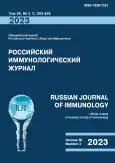Study of oxidative phosphorylation and glycolysis in CD4+T lymphocytes of HIV/HCV coinfected immunological non-responders by means of the seahorse technology
- Authors: Korolevskaya L.B.1, Vlasova V.V.1, Shmagel N.G.1, Saidakova E.V.1
-
Affiliations:
- Institute of Ecology and Genetic of Microorganisms, Perm Federal Research Center, Ural Branch, Russian Academy of Sciences
- Issue: Vol 26, No 3 (2023)
- Pages: 307-312
- Section: SHORT COMMUNICATIONS
- URL: https://journals.rcsi.science/1028-7221/article/view/253407
- DOI: https://doi.org/10.46235/1028-7221-9936-SOO
- ID: 253407
Cite item
Full Text
Abstract
Oxidative phosphorylation and glycolysis are essential for CD4+ T-lymphocyte survival, division, and functioning. However, indirect evidence suggests that in HIV-positive hepatitis C virus (HCV) coinfected immunological non-responders to antiretroviral therapy, the CD4+ T-cell metabolic activity parameters are violated. This information implies that in immunological non-responders, CD4+ T-lymphocytes' inability to productively divide and increase in number after viral suppression by antiretroviral drugs may be due to metabolic dysfunction. The newly released technology for the analysis of extracellular fluxes using seahorse XF equipment permits assessment of the cells’ metabolic activity. The aim of this study was to evaluate the efficiency of oxidative phosphorylation and glycolysis in CD4+ T-lymphocytes of HIV/HCV coinfected immunological non-responders using Seahorse technology. Peripheral blood samples from patients of two groups were studied: HIV/HCV coinfected immunological non-responders with CD4+ T-lymphocyte count less than 350/µl and HIV/HCV coinfected immunological responders with CD4+ T-cell count more than 500/µl. In isolated CD4+ T-lymphocytes, the basal and maximal oxygen consumption rates by complexes of the mitochondrial electron transport chain, as well as the rate of medium acidification by protons formed during glycolysis, were assessed. It has been established that in HIV/HCV coinfected immunological non-responders, both basal and maximal oxygen consumption rates by CD4+ T-cell mitochondria are reduced. Moreover, in isolated CD4+ T-lymphocytes of immunological non-responders, the basal rate of glycolysis is increased. It can be assumed that a significant part of CD4+ T-lymphocytes in HIV/HCV coinfected immunological non-responders is activated and ready for homeostatic proliferation, which aggravates the need for additional energy and macromolecules. However, cells are unable to change their metabolism in a coordinated manner to meet these demands. The identified dysregulation of metabolic pathways may contribute to the low regenerative capacity of CD4+ T-lymphocytes in HIV/HCV coinfected immunological non-responders.
Full Text
##article.viewOnOriginalSite##About the authors
Larisa B. Korolevskaya
Institute of Ecology and Genetic of Microorganisms, Perm Federal Research Center, Ural Branch, Russian Academy of Sciences
Author for correspondence.
Email: bioqueen@mail.ru
ORCID iD: 0000-0001-9840-7578
PhD, Research Scientist, Laboratory of Ecological Immunology
Russian Federation, 13 Golev St., Perm 614081, ПермьVioletta V. Vlasova
Institute of Ecology and Genetic of Microorganisms, Perm Federal Research Center, Ural Branch, Russian Academy of Sciences
Email: violetbaudelaire73@gmail.com
Junior Research Scientist at the Laboratory of Molecular Immunology
Russian Federation, 13 Golev St., Perm 614081, ПермьNadezhda G. Shmagel
Institute of Ecology and Genetic of Microorganisms, Perm Federal Research Center, Ural Branch, Russian Academy of Sciences
Email: shmagel_ng@iegm.ru
Dr. Sc. (Med.), Senior Research Scientist at the Laboratory of Ecological Immunology
Russian Federation, 13 Golev St., Perm 614081, ПермьEvgeniya V. Saidakova
Institute of Ecology and Genetic of Microorganisms, Perm Federal Research Center, Ural Branch, Russian Academy of Sciences
Email: radimira@list.ru
Dr.Sc. (Biol.), Head of the Laboratory of Molecular Immunology
Russian Federation, 13 Golev St., Perm 614081, ПермьReferences
- N.G. Shmagel, K.V. Shmagel, V.A. Chereshnev. Clinical aspects of inefficiency of highly active antiretroviral therapy. Infectious Diseases, 2011, Vol.9. no. 1, pp. 5-10.
- Autran B., Carcelaint G., Li T. S., Gorochov G., Blanc C., Renaud M., Durali M., Mathez D., Calvez V., Leibowitch J., Katlama C., Debre P. Restoration of the immune system with anti-retroviral therapy. Immunol Lett, 1999, Vol. 66, no. 1-3, pp. 207-211.
- Chen, T. Y., E. L. Ding, G. R. Seage Iii, and A. Y. Kim. Meta-analysis: increased mortality associated with hepatitis C in HIV-infected persons is unrelated to HIV disease progression. Clin Infect Dis, 2009, Vol. 49, no. 10, pp. 1605-1615.
- Grist J.T., Jarvis L.B., Georgieva Z., Thompson S., Kaur Sandhu H., Burling K., Clarke A., Jackson S., Wills M., Gallagher F.A., Jones J.L. Extracellular Lactate: A Novel Measure of T Cell Proliferation. J Immunol, 2018, Vol. 200, no. 3, pp. 1220-1226.
- Gutierrez F., Padilla S., Masia M., Iribarren J. A., Moreno S., Viciana P., Hernandez-Quero J., Aleman R., Vidal F., Salavert M., Blanco J. R., Leal M., Dronda F., Perez Hoyos S., del Amo J., and Ris Md Co. Patients' characteristics and clinical implications of suboptimal CD4 T-cell gains after 1 year of successful antiretroviral therapy. Curr HIV Res, 2008, Vol. 6, no. 2, pp. 100-107.
- Li X.B., Gu J.D., Zhou Q.H. Review of aerobic glycolysis and its key enzymes - new targets for lung cancer therapy. Thorac Cancer, 2015, Vol. 6, no. 1, pp. 17-24.
- Masson J.J.R., Cherry C.L., Murphy N.M., Sada-Ovalle I., Hussain T., Palchaudhuri R., Martinson J., Landay A.L., Billah B., Crowe S.M., Palmer C.S. Polymorphism rs1385129 Within Glut1 Gene SLC2A1 Is Linked to Poor CD4+ T Cell Recovery in Antiretroviral-Treated HIV+ Individuals. Front Immunol, 2018, Vol. 17, no. 9, p. 900.
- Wheaton W. W., Weinberg S. E., Hamanaka R. B., Soberanes S., Sullivan L. B., Anso E., Glasauer A., Dufour E., Mutlu G. M., Budigner G. S., Chandel N. S. Metformin inhibits mitochondrial complex I of cancer cells to reduce tumorigenesis. Elife, 2014, Vol. 3, no. 3, e02242.
- Younes S. A., Talla A., Pereira Ribeiro S., Saidakova E. V., Korolevskaya L. B., Shmagel K. V., Shive C. L., Freeman M. L., Panigrahi S., Zweig S., Balderas R., Margolis L., Douek D. C., Anthony D. D., Pandiyan P., Cameron M., Sieg S. F., Calabrese L. H., Rodriguez B., Lederman M. M. Cycling CD4+ T cells in HIV-infected immune nonresponders have mitochondrial dysfunction. J Clin Invest, 2018, Vol. 128, no. 11, pp. 5083-5094.
Supplementary files









